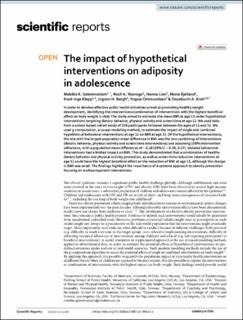| dc.contributor.author | Gebremariam, Mekdes Kebede | |
| dc.contributor.author | Nianogo, Roch A. | |
| dc.contributor.author | Lien, Nanna | |
| dc.contributor.author | Bjelland, Mona | |
| dc.contributor.author | Bergh, Ingunn Holden | |
| dc.contributor.author | Ommundsen, Yngvar | |
| dc.contributor.author | Arah, Onyebuchi A. | |
| dc.contributor.author | Klepp, Knut-Inge | |
| dc.date.accessioned | 2021-11-04T14:53:08Z | |
| dc.date.available | 2021-11-04T14:53:08Z | |
| dc.date.created | 2021-06-16T08:43:18Z | |
| dc.date.issued | 2021 | |
| dc.identifier.citation | Scientific Reports. 2021, 11(2021), Artikkel 11216. | en_US |
| dc.identifier.issn | 2045-2322 | |
| dc.identifier.uri | https://hdl.handle.net/11250/2827968 | |
| dc.description | This article is licensed under a Creative Commons Attribution 4.0 International License, which permits use, sharing, adaptation, distribution and reproduction in any medium or format, as long as you give appropriate credit to the original author(s) and the source, provide a link to the Creative Commons licence, and indicate if changes were made. The images or other third party material in this article are included in the article’s Creative Commons licence, unless indicated otherwise in a credit line to the material. If material is not included in the article’s Creative Commons licence and your intended use is not permitted by statutory regulation or exceeds the permitted use, you will need to obtain permission directly from the copyright holder. | en_US |
| dc.description.abstract | In order to develop effective public health initiatives aimed at promoting healthy weight development, identifying the interventions/combination of interventions with the highest beneficial effect on body weight is vital. The study aimed to estimate the mean BMI at age 13 under hypothetical interventions targeting dietary behavior, physical activity and screen time at age 11. We used data from a school-based cohort study of 530 participants followed between the ages of 11 and 13. We used g-computation, a causal modeling method, to estimate the impact of single and combined hypothetical behavioral interventions at age 11 on BMI at age 13. Of the hypothetical interventions, the one with the largest population mean difference in BMI was the one combining all interventions (dietary behavior, physical activity and screen time interventions) and assuming 100% intervention adherence, with a population mean differences of − 0.28 (95% CI − 0.59, 0.07). Isolated behavioral interventions had a limited impact on BMI. This study demonstrated that a combination of healthy dietary behavior and physical activity promotion, as well as screen time reduction interventions at age 11 could have the highest beneficial effect on the reduction of BMI at age 13, although the change in BMI was small. The findings highlight the importance of a systems approach to obesity prevention focusing on multicomponent interventions. | en_US |
| dc.language.iso | eng | en_US |
| dc.subject | medical research | en_US |
| dc.subject | risk factors | en_US |
| dc.title | The impact of hypothetical interventions on adiposity in adolescence | en_US |
| dc.type | Peer reviewed | en_US |
| dc.type | Journal article | en_US |
| dc.description.version | publishedVersion | en_US |
| dc.rights.holder | © The Author(s) 2021 | en_US |
| dc.source.pagenumber | 8 | en_US |
| dc.source.volume | 11 | en_US |
| dc.source.journal | Scientific Reports | en_US |
| dc.identifier.doi | 10.1038/s41598-021-90415-z | |
| dc.identifier.cristin | 1916018 | |
| dc.relation.project | Norges forskningsråd: 273823 | en_US |
| dc.description.localcode | Institutt for idrett og samfunnsvitenskap / Department of Sport and Social Sciences | en_US |
| dc.source.articlenumber | 11216 | en_US |
| cristin.ispublished | true | |
| cristin.fulltext | original | |
| cristin.qualitycode | 1 | |
